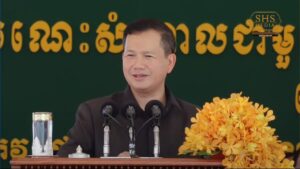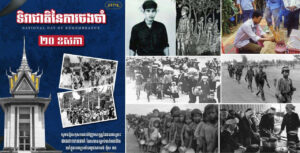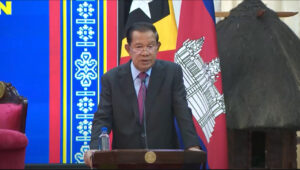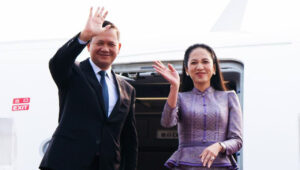Selected Comments Samdech Moha Bovor Thipadei Hun Manet, at the solidarity dinner and medals bestowment in honor of artists
 Selected Comments Samdech Moha Bovor Thipadei Hun Manet, at the solidarity dinner and medals bestowment in honor of artists
Selected Comments Samdech Moha Bovor Thipadei Hun Manet, at the solidarity dinner and medals bestowment in honor of artists
Selected Comments Samdech Moha Bovor Thipadei Hun Manet,
at the solidarity dinner and medals bestowment in honor of artists
[Unofficial translations]
(1) Globalization and integration of Cambodia – an opportunity to present the Khmer cultural identity on the international stage
Globalization and integration of Cambodia into the world stage gives us opportunities but also brings challenges. The opportunity arises from the integration into the international arena, especially in the field of culture, is that Cambodia has had a chance to show what it is like to be Cambodian, or the Cambodian identity, the Cambodian culture through many dance performances on national and international forums […] there are blessing dances, classical dances, contemporary dances, contemporary songs on various platforms with which we bring culture and art to the international shows. Organizing exhibitions in various international events and screening the Cambodian film abroad […], even the Hollywood film shot in Cambodia about the events of the Pol Pot era, help reveal the culture and civilization of Cambodia, which eventually replaces the story of the killing field […]
(2) Performance of Shaolin and Bokator martial arts – a positive result of Cambodian globalization
We have organized a show (of martial arts of the) Shaolin (monks from China) and (the Khmer martial arts) Bokator to show not only the audience in Cambodia but also those in China, and the world over, about exchange of traditional martial arts performance and the Cambodian arts and culture. This is a positive result of, (firstly,) the opportunity to participate in the globalization of Cambodia […]; secondly, the Cambodian integration into the world has provided opportunities for Cambodia’s creative culture industry to create a tourism market, providing opportunities for producers, artists, craftsmen, sculptors, whereas artisans, artifacts, souvenirs can have the opportunity to trade or offer to tourists who (visit and) buy them in Cambodia to bring back to their countries, and that would include also bringing these products to/for various exhibitions […]
(3) Cultural globalization blurs the line between cultures
The globalization and integration of Cambodia in the world has given us many opportunities, but at the same time, caused some problems for Cambodia, and many countries in the world too, related to the preservation of its culture […] Globalization has blurred the cultural delineation line between countries as global cultural flows, especially more influential cultures, namely Western influences, dominate those cultures that are not strong, through all means – film, materials, arts, music, etc. […] The fact that people, especially the youth, embrace the influence of these cultures has diminished the delineating line and understanding of the culture of each country […], which can pose a risk to the cultural traditions of each country in the long run […] This does not mean that we do not celebrate the events, or accept products or a rich spectacle of external influence. We do not forbid foreign films from being shown in our country. We do not forbid the Valentine Day of February 14 or Christmas, […] we welcome them all, but what I wanted to say is that our people must be clear about what is the Cambodian culture, what are the foreign cultures, and what is the transculturation […]
(4) Conservation and development must move forward together
(All this) has to do with the preservation and development of our culture/arts. Preserving culture is not just about keeping what is in the past, but also keeping our national identity at present and in the future. In fact, both conservation and development must move forward together. Preservation is the keeping the original identity of our culture, arts, tradition, religion, but we cannot be too conservative to not open for development in line with the evolution of society, economy, as well as the way of life of our people in the new era […] The creative development and innovation of new works are necessary, especially in the field of arts and culture to help promote the works of the Cambodians […] I believe that artists can be creative and innovative […] to promote the national culture and to make sure that conservation and development goes hand in hand for to survive for thousands of years to come […]
(5) Undocumented evolution will lead to the gradual disappearance of identity
In order for conservation and development to take place, especially at the turn of globalization, it is necessary to know clearly, to conduct thorough research, to have a well-documented training base for people of all generations to learn what is truly Khmer, what needs to be developed, what belongs to foreign cultures that we use without discrimination, and what is cross-cultural or transculturation, influencing on each other […] There needs to be a well-documented research record as the basis. If we make baseless developments, without documentations, our identity will gradually disappear […] (therefore, it is necessary) to identify and maintain them for long-term (conservation and development). (Otherwise,) due to pressure or the richness of globalization, the influx of foreign cultures, as well as the richness of global culture, the culture in our country may gradually be forgotten […]
(6) Researching and documenting the seven art forms while losing elderly artists
The second point is not only to compile, but also to conduct outreach training, especially to build human resources. We have seven art forms, all of which need to be researched and compiled, especially in the current phase where we are facing a lack of human resources, and losing some of the older artists in some art forms […] The government of the seventh legislative term has set a training plan for 1.5 million people, of which 2% to 4% of the scholarships are provided for ancestral skills training or for the Cambodian youth to learn related skills in culture and arts […] The third point is to promote and help with orientation […] There are a lot of Cambodians, especially young people, who have the will to produce and promote the arts and culture. This is a very good spirit […] This revival will be a positive sign and a necessary factor in preserving the culture and that the people continue to support, use and implement […]
(7) More than 2,000 artists represent tens of thousands of tangible heritages
Today, those who play a key role in preserving the arts and culture are the more than 2,000 brothers and sisters here, symbolizing the tens of thousands of artists across the country who are the main operators, the successors of the tangible heritage […] What we advertise in forums or movies must have a clear foundation to show to foreigners and/or to the Cambodians that this is Khmer, […] Misunderstanding can create conflict. I am asking for understanding […] Since we situate close to each other, there is a crossing over of ancient cultural traditions between each other, such as celebrating the New Year/Sankranta at the same time. Mutual understanding is essential. We depend on each other. This is the cause of living in harmony and participating in the preservation of national culture, as well as maintaining friendship with all nations without discrimination […]./.






